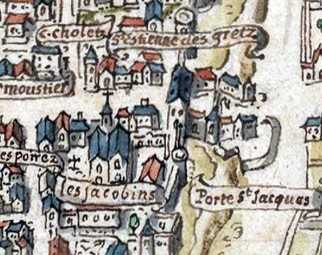Sancti Jacobi domus Parisius
Couvent de Saint-Jacques de Paris
“I don't understand, magister Johannes. Why did you come all the way here... when you are decanus of Sancti Quintini?” “I am always surprised by your questions, frater Mateus. Honorius, our dearest guide and servant, requested that you shall be taught the holy art of the sacra pagina. It was only natural that I voluntarily stepped down from my less important duties in the North. After all, you are the ones who will tell the Joyous Word to the deepest of misery and the wildest of inlands. Now, will you stop thinking people always have selfish motives? I will have to give you special lectio subjects to get rid of these worries of yours.”In 1215, Domingo Núñez de Guzmán founds the Dominican order or Ordo Predicatorum, but there is no home for his followers yet. A few years later, the Saint-Jacques convent becomes a bruistling house full of students, and in decennies to follow it will possess a magnificent library and be chosen by prestigious scholars as their studium, their classrooms. The convent even gives its name to the order : the Dominican Preachers are also called Jacobins in French, although they themselves prefer to use Latin and refer to each other with the old affective name of brothers, fratres.
Structure
Public Agenda
Assets
Here is what the convent looks like in the middle of the 18th century, labelled as Jacobins. Left is the Sorbonne, and above that, with only the corner visible, the Jesuite College. It now takes a whole block, with two courts, an enormous chapel and a gigantic school, below the picture, all along the great court planted with trees.
History

Laudare, benedicere, praedicare
1217 - 1790
Vincent de Beauvais
What about Time Lock people ?
Remove these ads. Join the Worldbuilders Guild










Comments
Author's Notes